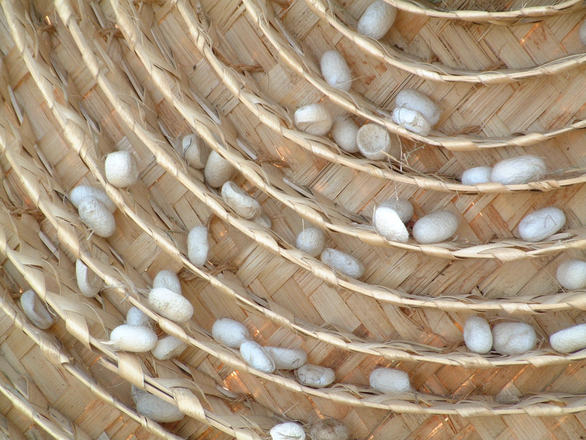The results of a recent Associated Press (AP) investigation met with a lot of teeth. Dental professionals snarled. The rest of us smiled. For the AP found little evidence to back up the long-touted benefits of flossing.
Let’s run some floss through the etymology of floss and see what we can dislodge from its pearly whites.

Floss
The Oxford English Dictionary first cites floss-silk in a 1759 report by Samuel Pullein to the Royal Society of London, “A new improved Silk-Reel.” In it, Pullein describes “floss-silk,” or filaments of silk. The following year, Pullein uses floss as such in reference to the cocoon of the silkworm. (Mr. Pullein was quite taken by silk; he even translated a 15th-century field manual on the silkworm written in Latin verse.)
Now, Pullein’s “floss-silk” would appear to translate the French soie floche, again “floss-silk.” Earlier forms of floche point to “tuft of wool,” suggest a root in Latin’s floccus, meaning “tuft of wool” or “lock of hair.” An English word flock, unrelated to groups of birds or sheep, is also so derived.
Walter Skeat, however, argues floss came directly from the Italian floscia seta, “sleave silk,” ultimately from the Latin flux, “flowing.” He considers soie floche the French borrowing of the same Italian phrase.
Floss may also have come from a native English dialect or Scandinavian word for floss spun from the same root as fleece. Fleece, the “wool coat of a sheep,” also denoted “fur” and “sealskin” in its earlier Old English forms. Its origin is Germanic, possibly cousin to Indo-European roots for “pluck” and “feather” and seen in words like plume.
Over a century after Pullein, floss names “fine, silk filaments” in general – and was applied to that most inelegant of threads, dental floss, often called dental silk early on. As a term, dental floss was threading English teeth in the final quarter of the 19th century, maybe as early 1872. Floss was common shorthand for this toothy cord by the 1930s.
James Joyce again elevated silky fibers to literary heights in his 1922 Ulysses, when Professor MacHugh attends to some oral hygiene in “Aeolus”:
He took a reel of dental floss from his waistcoat pocket and, breaking off a piece, twanged it smartly between two and two of his resonant unwashed teeth.
–– Bingbang, bingbang.
As far as the AP is concerned, we should tell the professor to skip the flossing and get right to those resonant, unwashed teeth.
Latin has flōs (genitive flōris) meaning ‘blossom’, ‘flower’ primarily but figuratively it could mean the ‘first downy hairs of the beard’ the sparse adolescent first beard growth or ‘bum-fluff’ as we’d say today.
LikeLike
Interesting connection. But what English have picked up this nominative form (cf. ‘floral’) and so dramatically shifted the vowel?
LikeLike
OED examples of “flux silk” and “floch silk” as alternative spellings of “floss silk” do suggest a French ‘soie floche’ rendering in English. The French dictionary suggests that ‘floche’ as a noun is derived from ‘floc’ from Latin floccus while the adjective (floche) is borrowed from Gascony ‘floche’ (flabby, not firm) from Latin flexus (bending, turning, winding) although a different dictionary says Latin fluxus (flowing, fluid, loose).
The Welsh for ‘floss silk’ is “sidan bras” where I think ‘bras’ in this case is meaning ‘rough, coarse’ qualifying the noun ‘sidan’ (silk) and there’s also ‘sidanblu’ which can mean ‘floss’ or ‘soft downy feathers’ (feather = ‘pluen’).
LikeLike
Many tempting and likely contenders with the etymology of “floss,” there are.
LikeLike